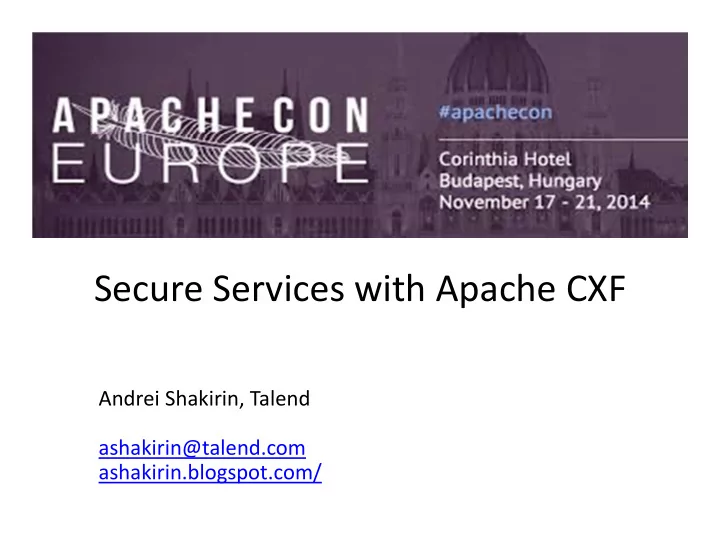

Karlsruher Entwicklertag 2014 Secure Services with Apache CXF Andrei Shakirin, Talend ashakirin@talend.com ashakirin.blogspot.com/
Agenda • Introduction in Apache CXF • Security Requirements • Apply security features to CXF Services (JAX-RS)
About Me • Software architect in Talend Team • PMC and committer in Apache CXF and commiter in Apache Syncope projects • Speaker for Apache and Java conferences
Apache CXF
Why CXF? CXF Benefits: Alternatives: � Strong standards support • Jersey � SOAP & Rest services • RestEasy � Comprehensive Security • Axis 2 • Metro � Streaming and performance … • � Flexibility � Large and active community
Who uses CXF? • Apache: Camel, ServiceMix, Syncope • JBoss JAX-WS stack • TomEE JAX-WS and JAX-RS stacks • Talend, Fusesource, MuleSoft, WSO2 • Google Adwords, TomTom, …
Security Requirements • Authentication (HTTP basic, digest, UsernameToken, X500, Kerberos, SAML) • Authorization (method/resource based, XACML) • Confidentiality (SSL, message encryption) • Integrity (SSL, message signature) • Non-repudiation (message signature)
Transport Layer Security • Authentication • Confidentiality • Integrity
Is SSL Safe?
SSL Handshake
Server Certificate Validation 1. Check certificate validity period 2. Check is Certificate Authority (CA) a trusted CA 3. Check the issuer's digital signature in whole chain 4. Check if domain name in the server's certificate match the domain name of the server itself 5. Check CA revocation list
Recommendations • Apply negative security tests using abnormal SSL certificates (self-signed, issues for another host, etc) • Don‘t modify application code and disable certificate validation even for testing • Verify libraries default set up, use explicit options if necessary
HTTPS: JAX-RS 2.0 Client
HTTPS: CXF Client
HTTPS Server: Jetty
Authentication • HTTP basic, digest • Kerberos • X509 • SAML • JWT
HTTP Basic 1. Client: GET /users/ua1b2c3 HTTP/1.0 2. Server: HTTP/1.0 401 Unauthorized WWW-Authenticate: Basic realm=" nmrs_m7VKmomQ2YM3: " 3. Client: GET /users/ua1b2c3 HTTP/1.0 Authorization: Basic QWxhZGRpbjpvcGVuIHNlc2FtZQ==
HTTP Digest 1. Client: GET /users/ua1b2c3 HTTP/1.0 2. Server: HTTP/1.0 401 Unauthorized WWW-Authenticate: Digest realm="testrealm@host.com", qop="auth,auth-int", nonce="dcd98b7102dd2f0e8b11d0f600bfb0c093", opaque="5ccc069c403ebaf9f0171e9517f40e41" 3. Client: GET / /users/ua1b2c3 HTTP/1.0 Authorization: Digest username=“ashakirin", realm="testrealm@host.com", nonce="dcd98b7102dd2f0e8b11d0f600bfb0c093", uri="/dir/index.html", qop=auth, nc=00000001, cnonce="0a4f113b", response="6629fae49393a05397450978507c4ef1", opaque="5ccc069c403ebaf9f0171e9517f40e41" HA1=MD5(username:realm:password) HA2=MD5(method:digestURI) response=MD5(HA1:nonce:HA2)
JAAS
Kerberos
SAML
SAML in Rest Services 1. Enveloped <env:Envelope xmlns:env="http://org.apache.cxf/rs/env"> <Book ID="67ca6441-0c4e-4430-af0e-9463ce9226aa"> <id>125</id> <name>CXF</name> </Book> <!-- SAML assertion with an enveloped signature --> <saml2:Assertion> ... </saml2:Assertion> </env:Envelope> 2. Authorization header Address: https://localhost:9000/samlheader/bookstore/books/123 Http-Method: GET Headers: {Accept=[application/xml], Authorization=[SAML eJydV1mTokgQf …]} 3. Form values Encoding: ISO-8859-1 Http-Method: POST Content-Type: application/x-www-form-urlencoded Headers: {Accept=[application/xml], Cache-Control=[no-cache], connection=[keep- alive] Payload: name=CXF&id=125&SAMLToken=eJydV1tzqkgQfs+vsDiPWcNFjWIdUzUIGqJ
Use Case for WS-Trust
WS-Trust: Security Token Service
JSON Web Token Signature = HMACSHA256(BASE64URL(UTF8(JWT Header)) + ’.’ + BASE64URL(JWT Claims), key)
Choose Authentication Method What kind of credentials users will provide for the authentication • (passwords, smart cards, public/private keys)? Which authentication methods are supported by existing • infrastructure? Should you support Single sign-On? • Is it necessary to associate additional data with user principals? • Do you need to communicate with external services? •
Authorization • Container based • Simple (mapping user -> role, method -> role) • Annotation based • XACML • OAuth
XACML
OAuth 2.0 Diagram from OAuth 2.0 spec
OAuth 2.0
Choose Authorization Method • What kind of resources should be protected? • Does your Web / Application Server provide authorization? • What information is required to make authorization decision? • Do you need to provide limited access to resources for the third parties?
Message Level Security: XML XML Signature and Encryption • JAX-WS: WS-Policy, WSS4J • JAX-RS: Enveloped, Enveloping and Detached Signatures, Encryption
XKMS Use Case
XML Key Management Service
JSON Web Signature JwsJsonWriterInterceptor; • JwsJsonClientResponseFilter and JwsJsonContainerRequestFilter •
JSON Web Encryption JweWriterInterceptor; • JweClientResponseFilter and JweContainerRequestFilter •
JWS/JWE in CXF
Conclusion 1. CXF provides a wide range of security solutions: from very simple to really complicated 2. Choice of the security features for your services is based on use case, requirements and existing infrastructre 3. Follow standards and prefer established solutions to secure your services 4. Check security issues for using frameworks 5. Apply negative security tests as part of your system or integration tests
Links • CXF Rest Services security: http://cxf.apache.org/docs/secure-jax-rs-services.html • CXF Soap Services security: http://cxf.apache.org/docs/ws-security.html http://cxf.apache.org/docs/ws-trust.html http://cxf.apache.org/docs/ws-securitypolicy.html • Blogs: http://ashakirin-cxf-security.blogspot.de/ http://coheigea.blogspot.de/ http://sberyozkin.blogspot.com
OAuth 2.0 in CXF
Recommendations • Don't implement your own security • Analyse and evaluate possible attacks • Apply negative security tests • Use black box testing tools: WS-Attacker (Ruhr-University Bochum, sourceforge) • Check certificates, passwords policy, using algorithms and keys for low-level libraries and framewroks • Default settings must be secure • Check security issues for using frameworks
CXF Security Advisories
XKMS Use Case
XML Key Management Service
Attacks and Vulnerabilities Replay • Injection (XPath, XML) • Wrapping • Spoofing (SOAPAction, WS-Addressing) • XML DOS (Oversized XML, XML Bomb) • Cross-site scripting (XSS: client side script injection) • Cross-site request forgery (CSRF) •
Signature Wrapping Attack <soap:Envelope .> <soap:Header> <wsse:Security> <ds:Signature> <ds:SignedInfo> <ds:CanonicalizationMethod Algorithm=".../xml-exc-c14n#" /> <ds:SignatureMethod Algorithm="...#rsa-sha1" /> <ds:Reference URI="#theBody"> <ds:Transforms> <ds:Transform Algorithm=".../xml-exc-c14n#" /> </ds:Transforms> <ds:DigestMethod Algorithm=".../xmldsig#sha1" /> <ds:DigestValue>AbCdEfG0123456789... </ds:DigestValue> </ds:Reference> </ds:SignedInfo> <ds:SignatureValue>AbCdEfG0123456789... </ds:SignatureValue> <ds:KeyInfo> <wsse:SecurityTokenReference> <wsse:Reference URI="#X509Token" /> </wsse:SecurityTokenReference> </ds:KeyInfo> </ds:Signature> </wsse:Security> </soap:Header> <soap:Body wsu:Id="theBody"> <getQuote Symbol=”IBM” /> </soap:Body> </soap:Envelope>
Signature Wrapping Attack <soap:Envelope .> <soap:Header> <wsse:Security> <ds:Signature> <ds:SignedInfo> <ds:Reference URI="#theBody"> <ds:Transforms> <ds:Transform Algorithm=".../xml-exc-c14n#" /> </ds:Transforms> </ds:Reference> </ds:SignedInfo> <ds:SignatureValue>AbCdEfG0123456789...</ds:SignatureValue> </ds:Signature> </wsse:Security> <!-- ... --> <!-- Original SOAP Body is placed below --> <!--.... --> <wrapper> <soap:Body wsu:Id="theBody"> <getQuote Symbol=”IBM” /> </soap:Body> </wrapper> </soap:Header> <!-- ... --> <!-- Maliciously modified SOAP Body is placed below --> <!--.... --> <soap:Body wsu:Id="#theBody"> <getQuote Symbol=”Evil” /> </soap:Body> </soap:Envelope>
Configure SSL in CXF Client: Service:
JWT JSON: JWS, JWE, JWT, JOSE Possible with external libraries Jose4J, JsonCrypto • Tight integration is in the pipe line •
Recommend
More recommend